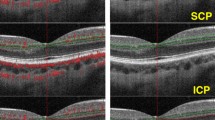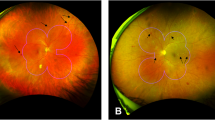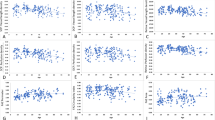Abstract
Background
The purpose of this study was to quantify retinal capillary density and foveal avascular zone (FAZ) area in healthy subjects according to their ethnicity, using optical coherence tomography angiography (OCTA).
Methods
In this cross-sectional study, all eyes underwent swept-source OCTA (Triton, Topcon, Tokyo, Japan). Macular OCTA scans (3 × 3 mm) were obtained in healthy white Caucasian and black African subjects. The FAZ area and capillary density in both the superficial (SCP) and deep capillary plexuses (DCP) were automatically measured using a custom-made software combining vessel binarization and skeletonization.
Results
Twelve eyes of 12 healthy Caucasians and 15 eyes of 15 healthy black Africans were included in the analysis. The mean FAZ area was significantly smaller, and the overall vessel density (VD) was higher in the SCP and DCP of Caucasians compared to black Africans. The mean FAZ area was 0.26 ± 0.008 mm2 in the SCP and 0.25 ± 0.05 mm2 in the DCP in Caucasians versus 0.33 ± 0.08 mm2 in the SCP (p = 0.01) and 0.37 ± 0.1 mm2 in the DCP (p = 0.03) in Africans. In the SCP and DCP, the mean VD was, respectively, 40.5 ± 0.8% and 47.1 ± 0.5% in Caucasians versus 34.3 ± 1% (p = 0.008) and 40.6 ± 0.9% in Africans (p < 0.001).
Discussion/conclusion
In the SCP and DCP, VD is lower in black Africans compared to Caucasians. In OCTA studies on vascular diseases, ethnicity-matched measurements from healthy subjects should be used for comparisons.



Similar content being viewed by others
Availability of data and material
All data are available upon motivated request at Audrey.giocanti@aphp.fr for 1 year.
Abbreviations
- DCP:
-
Deep capillary plexus
- FAZ:
-
Foveal avascular zone
- ICP:
-
Intermediate capillary plexus
- OCTA:
-
Optical coherence tomography angiography
- SCP:
-
Superficial capillary plexus
- VD:
-
Vessel density
References
Spaide RF, Klancnik JM, Cooney MJ (2015) Retinal vascular layers imaged by fluorescein angiography and optical coherence tomography angiography. JAMA Ophthalmol 133:45–50
Savastano MC, Lumbroso B, Rispoli M (2015) In vivo characterization of retinal vascularization morphology using optical coherence tomography angiography. Retina Phila Pa 35:2196–2203
Hwang TS, Zhang M, Bhavsar K et al (2016) Visualization of 3 distinct retinal plexuses by projection-resolved optical coherence tomography angiography in diabetic retinopathy. JAMA Ophthalmol 134:1411–1419
Roisman L, Goldhardt R (2017) OCT angiography: an upcoming non-invasive tool for diagnosis of age-related macular degeneration. Curr Ophthalmol Rep 5:136–140
Pichi F, Sarraf D, Arepalli S et al (2017) The application of optical coherence tomography angiography in uveitis and inflammatory eye diseases. Prog Retin Eye Res 59:178–201
Bousquet E, Bonnin S, Mrejen S et al (2018) Optical coherence tomography angiography of flat irregular pigment epithelium detachment in chronic central serous chorioretinopathy. Retina Phila Pa 38:629–638
Samara WA, Shahlaee A, Adam MK et al (2017) Quantification of diabetic macular ischemia using optical coherence tomography angiography and its relationship with visual acuity. Ophthalmology 124:235–244
Yu J, Gu R, Zong Y et al (2016) Relationship between retinal perfusion and retinal thickness in healthy subjects: an optical coherence tomography angiography study. Invest Ophthalmol Vis Sci 57:OCT204–OCT210
Wagner-Schuman M, Dubis AM, Nordgren RN et al (2011) Race- and sex-related differences in retinal thickness and foveal pit morphology. Invest Ophthalmol Vis Sci 52:625–634
Tick S, Rossant F, Ghorbel I et al (2011) Foveal shape and structure in a normal population. Invest Ophthalmol Vis Sci 52:5105–5110
Sun W, Shen Y, Shan S et al (2018) Identification of TYR mutations in patients with oculocutaneous albinism. Mol Med Rep 17:8409–8413
King RA, Townsend D, Oetting W et al (1991) Temperature-sensitive tyrosinase associated with peripheral pigmentation in oculocutaneous albinism. J Clin Invest 87:1046–1053
Jagirdar K, Smit DJ, Ainger SA et al (2014) Molecular analysis of common polymorphisms within the human Tyrosinase locus and genetic association with pigmentation traits. Pigment Cell Melanoma Res 27:552–564
International HapMap 3 Consortium, Altshuler DM, Gibbs RA et al (2010) Integrating common and rare genetic variation in diverse human populations. Nature 467:52–58
Coscas F, Sellam A, Glacet-Bernard A et al (2016) Normative data for vascular density in superficial and deep capillary plexuses of healthy adults assessed by optical coherence tomography angiography. Invest Ophthalmol Vis Sci 57:211–223
Acknowledgements
Authors acknowledge AVOPH (Association for research and vision-Ophthalmology department Avicenne hospital) that paid English edition and publication fees.
Author information
Authors and Affiliations
Contributions
L.H. acquired the data and drafted the work; F.A. acquired the data and drafted the work; G.G. was involved in the acquisition of data and analysis and revising the work critically for important intellectual content; V.L., B.B., F.F. and A.G.A. were involved in the conception and design of the work and revising the work critically for important intellectual content.
Corresponding author
Ethics declarations
Competing interests
The authors have no competing interest that might have influence this work. Audrey Giocanti-Aurégan and Franck Fajnkuchen are consultants for Allergan, Bayer and Novartis. Bahram Bodaghi is consultant for Allergan, Bayer, Thea and Novartis. Gaspard Gazeau, Lindat Hrarat, Vincent Lévy, and Fatima Amari have nothing to disclose.
Ethics approval and consent to participate
A favorable opinion was obtained from the France Macula Federation ethics committee (number 2017-1201) who fully approved the study. A written informed consent was obtained from patients to participate the study. In France, collection of ethnical data is forbidden except if there is a scientific impact of the ethnic knowledge. In that case, it is allowed, as in our study.
Consent for publication
A written informed consent was obtained from patients for publication.
Additional information
Publisher's Note
Springer Nature remains neutral with regard to jurisdictional claims in published maps and institutional affiliations.
Rights and permissions
About this article
Cite this article
Giocanti-Aurégan, A., Gazeau, G., Hrarat, L. et al. Ethnic differences in normal retinal capillary density and foveal avascular zone measurements. Int Ophthalmol 40, 3043–3048 (2020). https://doi.org/10.1007/s10792-020-01488-0
Received:
Accepted:
Published:
Issue Date:
DOI: https://doi.org/10.1007/s10792-020-01488-0




